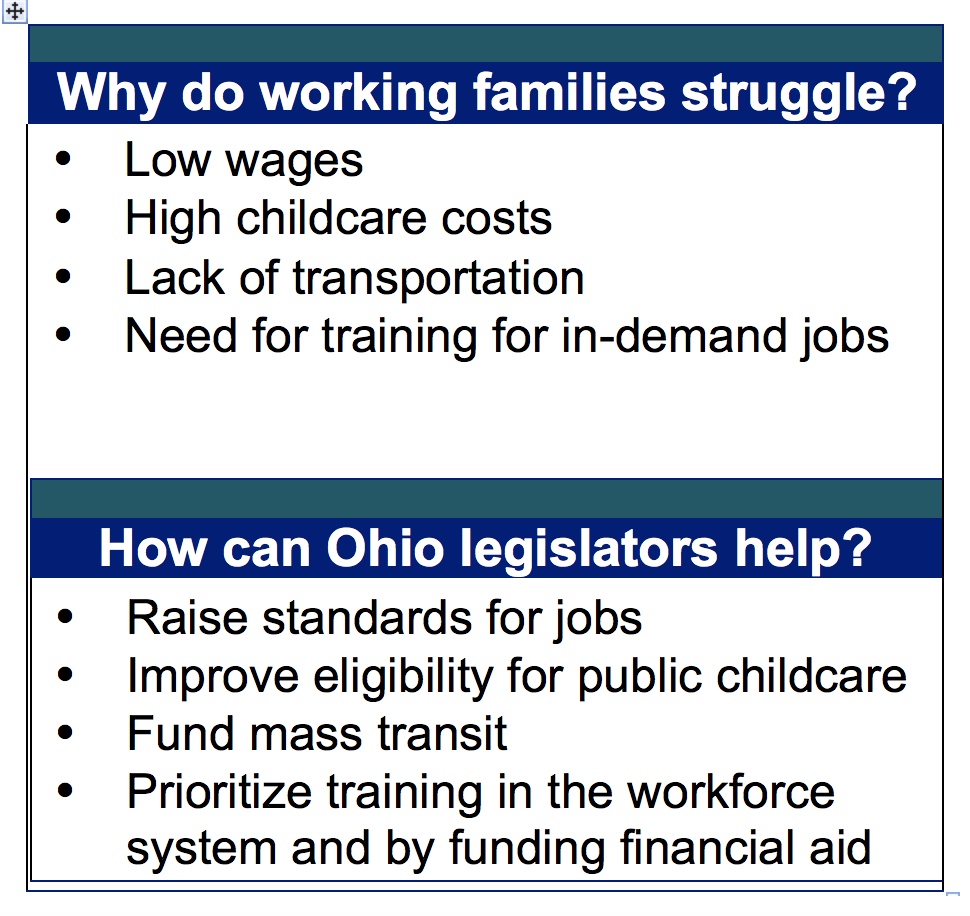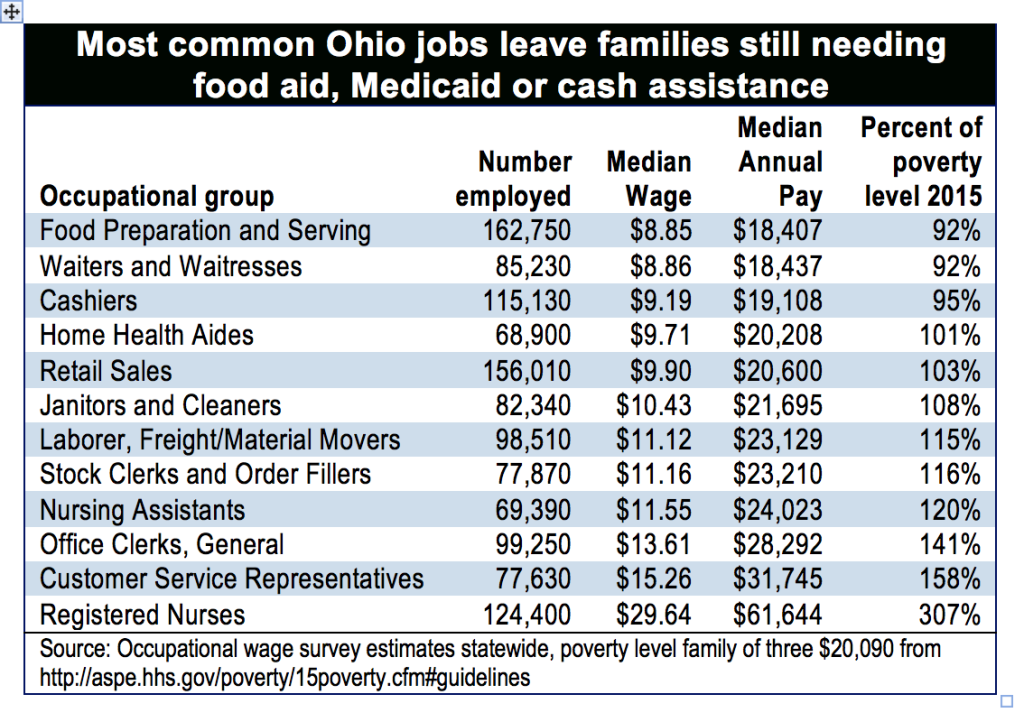
Testimony: Good jobs will help lift families out of poverty
August 12, 2015
Testimony: Good jobs will help lift families out of poverty
August 12, 2015
Lawmakers should focus on job quality as much as job creation.
Contact: Amy Hanauer, 216.361.9801
By Amy Hanauer
Good afternoon, Chairman Derickson, Vice Chair Ginter, Ranking Member Howse and members of the committee. Thanks so much for allowing us to testify here today.I’m Amy Hanauer, director of Policy Matters Ohio. We create a more prosperous, equitable and inclusive Ohio through research, coalition building and policy advocacy. We’re very happy about this committee, these hearings and your interest in improving the well-being and work situations of struggling Ohio families.
 At Policy Matters we spend a lot of time looking at jobs. We agree that it’s essential to ensure that people can find good jobs and support their families. Every year we put out a State of Working Ohio report around Labor Day, looking at whether Ohioans can find jobs, what those jobs pay, and whether workers can take care of themselves, their kids, and the other people they are responsible for. Job quality matters. Unfortunately, nothing will help families move forward if jobs pay too little. Ohio has done some excellent things to improve job quality, including keeping basic union rights in place, having a minimum wage above the federal level, and building solid practices for working with employers and unions to ensure well-trained workers for in-demand jobs. We could do more to improve job quality, but it’s not all within the mandate of this committee. Those things include raising the minimum wage, requiring paid sick days or ensuring that employers offer hours that let parents set up childcare in advance. One Ohio-based employer – Abercrombie and Fitch – just improved its nationwide practices on this last point. The state’s workforce development system could encourage other employers to adopt similar high-road employment practices.
At Policy Matters we spend a lot of time looking at jobs. We agree that it’s essential to ensure that people can find good jobs and support their families. Every year we put out a State of Working Ohio report around Labor Day, looking at whether Ohioans can find jobs, what those jobs pay, and whether workers can take care of themselves, their kids, and the other people they are responsible for. Job quality matters. Unfortunately, nothing will help families move forward if jobs pay too little. Ohio has done some excellent things to improve job quality, including keeping basic union rights in place, having a minimum wage above the federal level, and building solid practices for working with employers and unions to ensure well-trained workers for in-demand jobs. We could do more to improve job quality, but it’s not all within the mandate of this committee. Those things include raising the minimum wage, requiring paid sick days or ensuring that employers offer hours that let parents set up childcare in advance. One Ohio-based employer – Abercrombie and Fitch – just improved its nationwide practices on this last point. The state’s workforce development system could encourage other employers to adopt similar high-road employment practices.
But too many Ohio jobs do not pay enough to lift a family out of poverty. A report that Governor Kasich requested from the Ohio Workgroup to Reduce Reliance on Public Assistance found that jobs often don’t pay enough for families to take care of themselves, noting that a family of one adult and two children would need an annual income of $27,644 ($13.30 per hour) to no longer need cash assistance, food aid or Medicaid.[1] The report states that the “most basic requirement for successful economic independence is the availability of jobs paying wages sufficient enough to allow people to leave public assistance.” All but three of Ohio’s largest occupations pay a median wage below the report’s self-sufficiency threshold (see chart).[2] That’s why when we look at Ohio families earning less than 200 percent of the federal poverty level we find that nearly 70 percent are working.[3] As a result, connecting Ohioans to jobs will not necessarily mean families can escape poverty and afford the basics.
We hope that your mandate is not just “how can we move people off of public assistance” because unless there are decent, steady jobs, that approach could leave people worse off. It used to be that families (and even individuals!) who met income guidelines and were in deep poverty qualified for benefits like General Assistance and Aid to Families with Dependent Children. But we got rid of those programs so adults without children now can’t access any cash assistance, regardless of how high unemployment is. Then, with federal approval, Ohio created Ohio Works First, which has work requirements and time limits that didn’t used to exist. In just the past few years we’ve cut the number of people getting OWF in half (from 226,000 to 109,000) and we now have less than 16,000 adults who get cash assistance. But this hasn’t necessarily reduced poverty. According to a report the state commissioned, the single biggest reason that Ohioans left the Ohio Works First program was not that they got more income, but that they were sanctioned. Removing families from public assistance before they have skills or an alternative income could push people into more expensive programs, like emergency shelters and children’s services, leading to less stable families and communities.
We are very excited about many of your goals, particularly that of expanding economic opportunity to all Ohioans. We’re glad that you want to ask how Ohioans without a lot of formal skills can get the education and training that high-road employers need. And we’re thrilled to see you using your ingenuity to ask how low-income adults can get good jobs and move into the middle class.
You’ve asked whether state policy makes it easier or harder for families to get by and I want to unequivocally say that the country as a whole and the state of Ohio both do many things to ease poverty and help families. Our safety net nationally cuts poverty nearly in half – various public programs kept 41 million Americans out of poverty in 2012.[4]
But there are things we could be doing better – in some cases much better – and other states are passing us by. The other organizations testifying today and their partners across the state are part of the solution. I’d like to add five ideas, from my perspective as a researcher, for how state policy can better build an economy that works for all.
- Prioritize education and training: Ohio already has great apprenticeship programs. As we implement the new Workforce Innovation and Opportunity Act, we have a chance to further prioritize education and training for people with employment barriers. We should do this across all existing programs, and across new programs created. Under WIOA we can focus on sector partnerships and career pathways, where Ohio is already ahead of the curve and can go further. The program also incorporates a better understanding of the labor market. Because of all this, WIOA could transform the worker training and placement system.
- Make college affordable: Funding higher education is a great way that this state ensures that we have the educated workforce that we need. Ohio has excellent universities and strong community colleges (despite challenges). We also offer the Ohio College Opportunity Grant, which helps students who couldn’t otherwise afford higher education. The state expanded OCOG in the last budget and now offers the grant to some community college students enrolled in summer courses.
- Childcare is one of the biggest barriers that make it difficult for families to afford to work. So the fact that Ohio offers childcare assistance to help low-income families secure safe, quality care while parents are at work is essential. And Ohio has taken steps to improve its program in recent years after a steep decline. We recently made it slightly easier to qualify, eliminated copays for families earning less than the federal poverty level and helped ensure that parents don’t get kicked off in sudden ways that send them back into poverty.
- Earned Income Tax Credit: The federal EITC does more to bring low-income working families out of poverty than any other federal program. Nearly a million (963,000) Ohio workers get the federal credit, bringing $2.3 billion each year to Ohio’s families and communities. Ohio added a state EITC a few years ago, which is a great way to begin building on the federal benefits.
- Other Basics: Good training, good jobs, quality childcare and adequate income from those jobs would go a long way toward reducing poverty and giving parents the ability to support their families. Some other essentials include:
- Healthcare: Expanding Medicaid kept half a million Ohioans healthy and brought in billions in federal dollars, so we’re thankful that the legislature continued Medicaid expansion. As noted recently in the journal Health Affairs, an early form of Medicaid expansion piloted here at MetroHealth (Cuyahoga County’s public hospital) found Medicaid led to better control of diabetes and high blood pressure and also lowered costs. In one next step, we’d urge you to reverse the changes in the budget that request federal waivers to impose unnecessary requirements on patients – those requirements would prevent some people from getting the health care they need. This will undercut other steps that the committee may recommend to help struggling Ohioans.
- Transit: Along with childcare, lack of transportation is one of the biggest barriers that families face. Ohio does a particularly poor job of investing in transit. I’m thrilled to see that Joe Calabrese is here to provide some details on that.
- Local government: State budget cuts to support for local human service levies are hurting the ability of our local communities to deliver the basics. Recent cuts mean $17.4 million less for children’s service levies, $9 million less for public health levies, $53 million less for mental health and developmental disabilities levies over the 2-year budget. We should instead restore revenue so we can provide localities with what they need.
- Food: Kids can’t learn and parents can’t be effective workers or job applicants if they are hungry. Because we had high unemployment in Ohio, the federal government offered us a waiver of time limits on food aid. Ohio did not accept that waiver for Cuyahoga County in recent years, but going forward, nine cities and 34 counties will qualify again for waivers. Ohio should accept any waivers offered, to ensure that hungry Ohioans can get the nutrients they need to thrive at work and in school.
Policy Matters: Creating a more vibrant, equitable, inclusive Ohio.
[1] Workgroup to Reduce Reliance on Public Assistance, Report to Governor John R. Kasich and Ohio General Assembly, p 24, April 15, 2015, at http://humanservices.ohio.gov/WorkArea/DownloadAsset.aspx?id=2147636202, accessed May 5, 2015.
[2] Ohio Occupational Employment Statistics data, at http://ohiolmi.com/asp/oeswage/SOCWage.asp?Source=Wage, updated through June 2014, most recent available. The three occupations that pay a median wage over $13.30 are registered nurses ($29.64), office clerks ($13.61), and customer service ($15.26).
[3] Working Poor Families Project, Population Reference Bureau analysis of 2013 American Community Survey micro-data.
[4] Center on Budget and Policy Priorities, War on Poverty at 50, http://www.cbpp.org/research/chart-book-the-war-on-poverty-at-50-section-3?fa=view&id=4073
[5] See Hannah Halbert “The EITC in the Promise Neighborhood,” Policy Matters May 2014 at http://www.policymattersohio.org/central-eitc-may2014.
Photo Gallery
1 of 22
